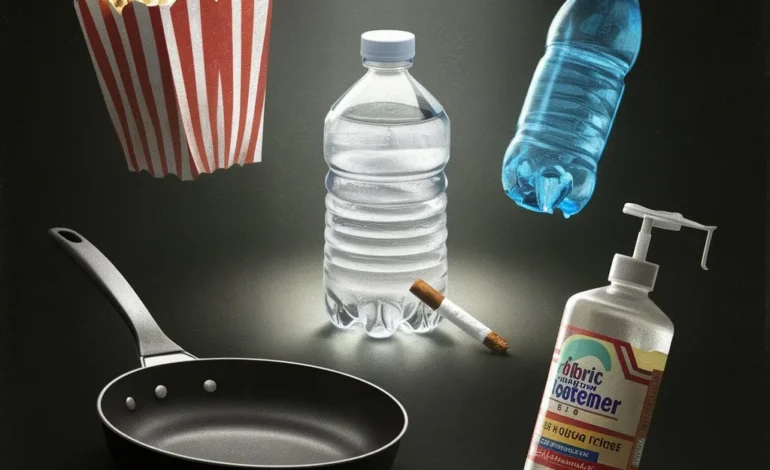Identifying Carcinogens in Everyday Household Items and Staying Safe

In our quest for a clean, comfortable, and fragrant home, we often overlook the potential dangers lurking in everyday household items. From the cleaning products we use to personal care items we trust, many household products contain carcinogens, posing serious health risks.
Understanding these hidden hazards is crucial for maintaining a safe living environment. In this article, we explore household items that may harbor carcinogens and offer practical tips for minimizing exposure and ensuring a healthier home.
Cleaning Products
Ingredients such as formaldehyde, chloroform, and benzene, found in some detergents, disinfectants, and air fresheners, are known carcinogens. To reduce exposure, opt for natural cleaning solutions like vinegar and baking soda, or choose products labeled as non-toxic and chemical-free. Always use cleaning products in well-ventilated areas and wear protective gloves to minimize direct contact.
Newsweek states that cleaning products release hundreds of hazardous chemicals into homes every day. A study found 193 hazardous volatile organic compounds in 30 common products, impacting respiratory health, development, reproduction, and cancer risk.
Cleaners face a 50% higher asthma risk and a 43% increased COPD risk. Opt for green, fragrance-free alternatives to reduce exposure by eightfold.
Personal Care Products
Personal care products, including shampoos, lotions, and cosmetics, often contain carcinogenic ingredients such as parabens, formaldehyde-releasing preservatives, and phthalates. Chemicals in hair straighteners can penetrate the skin and potentially increase cancer risk with prolonged use.
While these products are popular for creating smooth, sleek hair, frequent application can result in hair damage and breakage. Many of these straighteners include harmful chemicals like formaldehyde, which can pose serious health risks.
Research has established a connection between chemical hair straighteners and a higher likelihood of developing certain cancers. For instance, studies show that women who frequently use these products are at an elevated risk for uterine cancer. The presence of chemicals such as formaldehyde and other endocrine disruptors in these products may contribute to cancer risk.
The association between hair straighteners and cancer, particularly uterine cancer, has led many to file hair straightener cancer lawsuits. These lawsuits assert that the makers of chemical hair straighteners did not adequately inform consumers of the health risks tied to their products.
Plaintiffs argue that using these products, which include harmful substances like formaldehyde, greatly raises the risk of uterine cancer and other health problems. The lawsuits seek to obtain compensation for medical expenses, emotional suffering, and other damages resulting from the use of these dangerous products.
According to TorHoerman Law, there were 8,192 pending filings for the hair straightener lawsuit as of July. By August, this number had dropped to 7,946. This reduction is likely because some cases were dismissed for not meeting injury criteria or because duplicate cases were identified.
What certifications should I look for to ensure a product is free from carcinogens?
Look for certifications such as the EPA’s Safer Choice, USDA Organic, Green Seal, and EWG Verified. These labels indicate that products have been tested and meet stringent safety standards, ensuring they are free from harmful chemicals and carcinogens.
Plastic Containers and Bottles
Bisphenol A (BPA) and phthalates are two dangerous chemicals that can leak into food and beverages from plastic containers, particularly those made of polycarbonate. Numerous health issues, including cancer, have been linked to these substances.
Avoid heating food in plastic containers; use glass, stainless steel, or BPA-free plastics to reduce risk. Check recycling codes and avoid plastics marked with numbers 3 and 7, which likely contain BPA and harmful chemicals.
Mayo Clinic states that BPA, which has been used in plastics and resins since the 1950s, can seep into food from containers. A study showed BPA exposure affects fetuses, infants, and children, potentially causing brain and prostate issues. It may also raise blood pressure and diabetes risk. Despite the FDA’s assurance of BPA’s safety at low levels, opting for BPA-free products and avoiding heat can reduce exposure.
Non-Stick Cookware
Non-stick cookware, while convenient, often contains perfluorooctanoic acid (PFOA) and other per fluorinated compounds (PFCs), which are potential carcinogens. These chemicals can be released into the air and food when the cookware is heated to high temperatures.
To reduce exposure, use non-stick cookware at lower temperatures, replace old pans, or switch to stainless steel or cast iron. Proper ventilation while cooking can also help minimize inhalation of harmful fumes.
WebMD states PFOA in some Teflon-coated cookware is linked to kidney disease, liver disease, thyroid disorders, cancer, and infertility. A study revealed that 98% of Americans had PFOA in their blood. Despite the US EPA’s program to eliminate PFOA by 2015, environmental and health risks remain, especially when Teflon is overheated.
Are there any non-toxic, non-stick cookware options available?
Yes, non-toxic, non-stick cookware options include ceramic-coated pans and those made from cast iron, stainless steel, and carbon steel. Brands like GreenPan and Caraway offer ceramic-coated cookware free from PFOA, PTFE, and other harmful chemicals.
Air Fresheners and Scented Candles:
Air fresheners and scented candles may improve ambiance but can emit VOCs like benzene and formaldehyde, which are carcinogens. Prolonged exposure to these chemicals can increase cancer risk. For safer alternatives, use essential oil diffusers, beeswax candles, or simmer natural ingredients like citrus peels and cinnamon sticks on the stove.
According to NCBI, 65.7% of individuals used scented candles, with a notably higher rate among women (74.9% compared to 28.4% for men). Those who used candles frequently (5–6 times per week) reported fewer respiratory problems. However, those exposed for more than 60 minutes had a 1.42 times higher risk of headaches. Common health complaints included headaches (15.2%), shortness of breath (8.9%), and coughs (7.8%).
Can essential oils be a safe alternative to synthetic air fresheners?
Yes, essential oils can be a safe alternative to synthetic air fresheners. They are natural, free from harmful chemicals, and provide pleasant scents when used in diffusers or homemade sprays. However, ensure proper dilution and usage to avoid potential allergies or sensitivities.
Furniture and Carpets
Furniture and carpets can contain flame retardants, formaldehyde, and other chemicals that pose carcinogenic risks. These substances can off-gas into your home’s air over time, leading to potential health hazards.
To minimize exposure, choose furniture made from solid wood or materials with low chemical emissions and avoid carpets treated with harmful chemicals. Regular vacuuming with a HEPA filter and using an air purifier helps reduce the presence of toxic substances in your home.
Green Science Policy Institute states California’s 1975 flammability standard, TB 117, led to the widespread use of flame retardants in furniture. A study found that 85% of couches from 1984-2010 contained these chemicals, which are linked to lowered IQ, cancer, and hormone disruption. California revised TB 117 in 2013, reducing flame retardants in new furniture, effective from 2015.
Detox Your Living Space
Awareness of carcinogens in everyday household items is crucial for maintaining a healthy living environment. By choosing products with certifications like EPA’s Safer Choice, USDA Organic, and EWG Verified, you can reduce exposure to harmful chemicals.
Opt for non-toxic alternatives, such as ceramic-coated cookware and essential oils, to further minimize risks. Implementing these changes may require effort, but the benefits to your health and well-being are invaluable.









